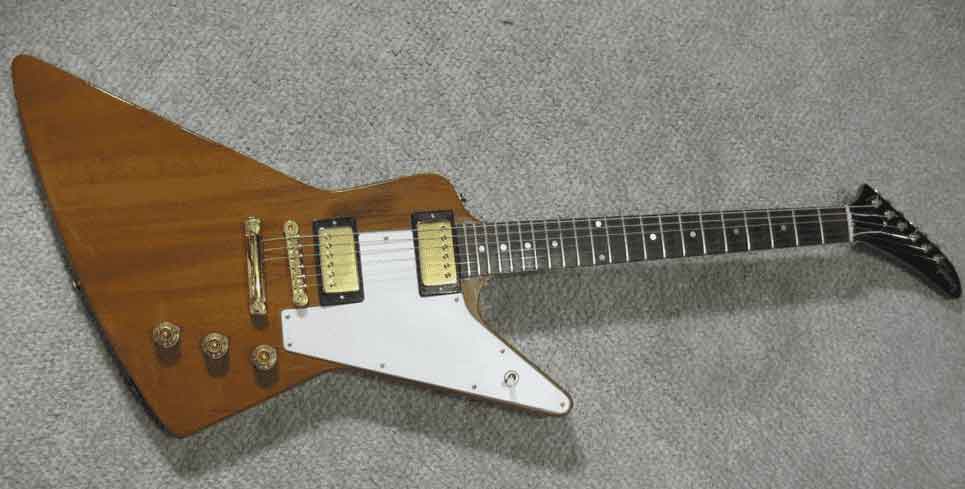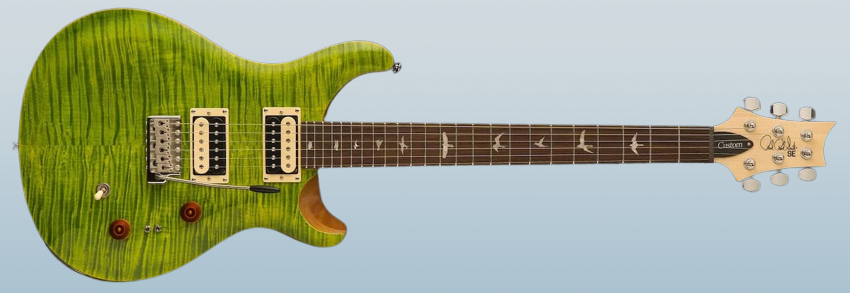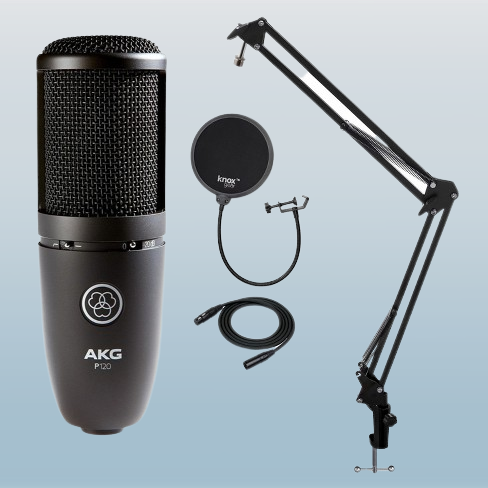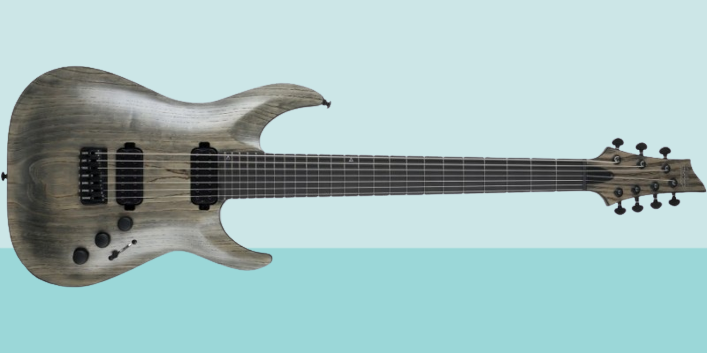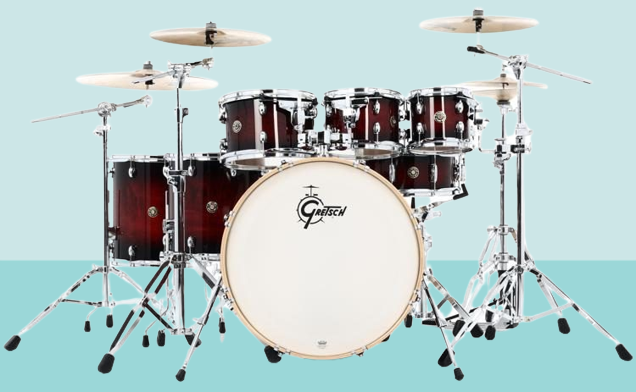First Impression
As a guitar player I’ve always enjoyed the sleek curves and stylish presence that the Gibson Explorer exudes. The first time I laid eyes on one was in middle school while visiting Guitar Center. Nothing else compared. With such a modern look it is surprising for most to learn that the Explorer models date as far back as the 1950s.
Overview of the Gibson Explorer
The Gibson Explorer is a solid-body electric guitar known for its distinct shape and powerful sound. In the late 1950’s Gibson released the Explorer guitar as one of their new ultra-modern design concepts. During this same time the Flying V was also released. A third model called the Moderne was also designed but never made it past the prototype phase.
Original Explorer models had very limited runs during this era. This model was designed in 1957 and less than 50 guitars were shipped from Gibson’s factory in 1958 and 1959. Because it is so rare, an Explorer produced between 1958 and 1960 is valued at about $300,000 to $600,000 depending on condition.
Each Explorer was expertly crafted using two PAF humbuckers, korina wood for the body, a stopbar tailpiece and tune-o-matic bridge. Not bad for a guitar made almost 60 years ago.
Gibson Re-releases The Explorer

After a short premier the Explorer went out of production until the mid 1970’s (1975 to be exact). Gibson made a few changes to the Explorer’s design in 1981, including “Dirty Finger” humbucker pickups (uncovered), a maple neck with Ebony fingerboard, and chrome-plated hardware.
The brand continues to produce Explorers that be be found on their website. Currently you can order this model on the Gibson website for about $1,999 for the base model.
Don’t miss out our full review on the 2015 Gibson line-up here.
Design and Build Quality
The design of the Gibson Explorer is bold and eye-catching. Its angular body shape and pointed headstock make it instantly recognizable. The build quality of the guitar is exceptional, with high-quality materials and expert craftsmanship. The mahogany body and neck provide a solid and resonant feel, while the rosewood fretboard offers smooth playability.
Sound and Tone
One of the standout features of the Gibson Explorer is its rich and versatile sound. The dual humbucker pickups deliver a wide range of tones, from warm and mellow to aggressive and gritty. The guitar excels in rock and metal genres, thanks to its ability to produce heavy distortion and sustain. However, it is also capable of producing smooth and clean tones, making it suitable for various musical styles.
Playability and Comfort
The Gibson Explorer offers excellent playability, making it a favorite among guitarists who value speed and precision. The slim-taper neck profile allows for comfortable and effortless playing, especially during fast and intricate passages. The fretboard radius is also well-suited for both rhythm and lead playing, ensuring easy string bending and chord voicings.
Versatility in Musical Styles
While the Gibson Explorer is often associated with rock and metal, it is a surprisingly versatile instrument that can handle various musical styles. Its powerful pickups and solid construction make it suitable for aggressive riffing, but it also shines in blues, jazz, and even country music. The tone controls and pickup selector offer ample flexibility to dial in the desired sound for different genres.
Unique Features
The Gibson Explorer has several unique features that set it apart from other guitars. Firstly, its unconventional body shape not only adds to its visual appeal but also contributes to its excellent balance and weight distribution. The dual humbucker pickups are another distinctive aspect, providing high-output and capturing every nuance of the player’s performance.
Comparison with Other Guitar Models
When comparing the Gibson Explorer with other guitar models, it stands out for its distinctive design, powerful sound, and excellent playability. While some guitars may offer similar tonal characteristics, the Explorer’s unique shape and construction make it a standout choice for those seeking a visually striking instrument that delivers both in terms of aesthetics and performance.
Pros and Cons
Like any guitar, the Gibson Explorer has its strengths and areas for improvement. Here are some of the pros and cons to consider:
Pros:
- Distinctive and visually striking design
- High-quality build and craftsmanship
- Powerful and versatile sound
- Excellent playability and comfort
- Suitable for various musical genres
Cons:
- The angular body shape may not be comfortable for everyone
- Heavier weight compared to some other guitar models
- Higher price point compared to entry-level guitars
- Limited availability of color options
- It’s important to note that these pros and cons are subjective and may vary depending on individual preferences and playing styles.
The Players Behind The Guitar
There have been a number of players who have made the Explorer their go to ax. Some of the more notable Rock Stars include The Edge, Billy Gibbons, and James Hetfield. Not bad for a guitar that has gone out of production twice.
Final Opinions
In conclusion, the Gibson Explorer makes a strong first impression with its unique design, powerful sound, and excellent playability. Whether you’re a rock enthusiast or a musician exploring different genres, the Explorer offers versatility and reliability. With its iconic shape and high-quality construction, this guitar is a worthy investment for players looking to stand out both visually and sonically.
FAQs
Can the Gibson Explorer be used for genres other than rock and metal?
Absolutely! While the Explorer is popular in rock and metal, its versatile sound makes it suitable for a wide range of musical styles, including blues, jazz, and even country.
Is the angular body shape comfortable to play?
The body shape may feel different at first, but many players find it comfortable once they get accustomed to it. It’s always recommended to try the guitar in person before making a purchase.
Are there any alternatives to the Gibson Explorer?
Yes, there are other guitar models with similar features and tonal characteristics. Some popular alternatives include the ESP Eclipse, Dean ML, and Jackson Rhoads.
Can I customize the pickups on the Gibson Explorer?
Yes, the Explorer allows for customization of pickups to suit your personal preference. There are various aftermarket options available to further enhance the guitar’s tone.
Does the Gibson Explorer come with a case or gig bag?
The Gibson Explorer typically comes with a hardshell case to protect the instrument during transportation and storage. Remember, if you’re interested in experiencing the Gibson Explorer firsthand, you can purchase a pre-owned Gibson guitar here.




